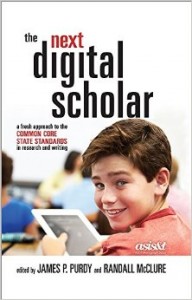The Next Digital Scholar: A Fresh Approach
The Next Digital Scholar: A Fresh Approach to the Common Core State Standards in Research and Writing
Edited by James P. Purdy and Randall McClure
(Information Today/Asis&t Monograph Series, 2014 – Learn more)

At nearly 550 pages, The Next Digital Scholar: A Fresh Approach to the Common Core State Standards in Research and Writing is certainly weighty on a literal scale. Luckily, what’s inside this hefty tome is also valuable information (even if I get a little wary these days of subtitles that reference the Common Core as a way to get our attention).
This edited collection of articles by educators across the teaching spectrum touches on a plethora of areas, from how technology impacts our writing, research and reading habits, to media literacy principles, to social justice and equity issues when it comes to how schools are using/not using technology.
Technology’s potential to transform learning

Writers Elizabeth Homan and Dawn Reed, for example, provide a fascinating portrait of a student who composes some writing, first with access to digital tools and then without such access. Homan and Reed make visible the ways in which their student, Hannah, pivots and uses the technology to her advantage, and how constrained she is when those options are taken away.
Homan and Reed move us through each stage of writing, as a sort of compare/contrast piece, and the findings are very interesting. By narrowing the focus on a single student in “Learning from Digital Students and Teachers: Reimagining Writing Instruction and Assessment for the 21st Century,” they make visible the compositional strategies often unseen by adult eyes.
Later, in a piece entitled “Media Literacy Principles and the Common Core State Standards in English Language Arts Teacher Education,” James Cercone and David L. Bruce examine the medium of visual literacy practices and how best to explicitly teach young people to use a rhetorical lens on multimedia. From YouTube, to memes, to video games, it’s media that bombards them each day of their life. A helpful chart (page 203) compares the literacy connections between Media Literacy studies and traditional ELA practices.
An intriguing chapter by Laura J. Davies, entitled “Browsing with Intent: Digital Information Literacy and Distant Reading Practices,” pushes our thinking about the kinds of reading our students are doing, and how we can best leverage online reading for deeper understanding of text. Instead of dismissing the idea of browsing, or power reading, Davies shows how one can balance both deep reading and skimming to find information that one needs, and how both are legitimate reading skills to be taught to students.
Facing challenges, remembering core principles
There are many more pieces I could reference here, but suffice it to say, the range of thinking is a lot to take in. Yet the the ground this book covers around digital literacy and student learning is important and well worth the time it takes to ingest all 500-plus pages.
As an afterword to The Next Digital Scholar, middle school teacher-turned-college professor Troy Hicks leaves us with a few more thoughts, in the form of challenges and principles (p. 497).
Hicks suggests we keep in mind that:
- While the Common Core offers a vision for curriculum, we must recognize where the concept of the Common Core came from and keep that in mind;
- Teachers must change our thinking about literacy practice, in light of the digital world, and we must act on that thinking now, not later;
- Reform initiatives must strengthen the links and connections between K-12 teachers and college programs.
Hicks then reminds us of some core principles:
- Good teaching practices can engage students in substantive digital writing;
- Balancing Internet policies in schools with classroom practice is crucial;
- Teachers need to be more interdisciplinary and cross more curriculum boundaries and move away from the silo model of narrow content-area instruction.
Kevin Hodgson is a sixth grade teacher in Southampton, Massachusetts, and is the technology liaison with the Western Massachusetts Writing Project. Kevin blogs regularly at Kevin’s Meandering Mind and tweets more often than is healthy under his @dogtrax handle. He also writes his Working Draft blog here at MiddleWeb.



































Thanks for the review!